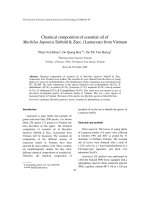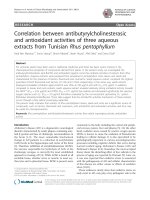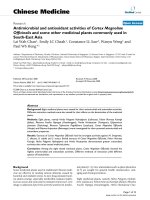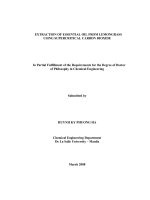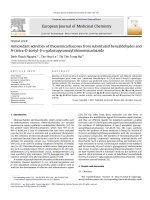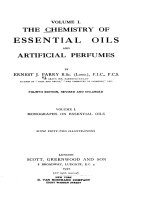ANTIOXIDANT ACTIVITIES OF ESSENTIAL OIL
Bạn đang xem bản rút gọn của tài liệu. Xem và tải ngay bản đầy đủ của tài liệu tại đây (26.24 MB, 27 trang )
VIETNAM NATIONAL UNIVERSITY, HANOI
VNU UNIVERSITY OF SCIENCE
FACULITY OF CHEMISTRY
***
Topic:
ANTIOXIDANT ACTIVITIES OF ESSENTIAL OIL
Supervisor: Dr. Nguyen Hoang Yen
Performed of students: Tran Thi Thuy Van
Hanoi – 2021
ACKNOWLEDGEMENT
First of all, I would like to express my gratitude and sincere thanks to
Dr. Nguyen Hoang Yen were helpful, oriented way of thinking and way of
doing science for children . Those are very valuable suggestions not only in
the process of making this thesis but also a stepping stone for me in the
process of studying and setting up a career in the future.
And finally, thank you to family and friends who are always willing to
share and help in study and life. Hopefully, we will stick together forever.
Wish the best will always accompany everyone.
Hanoi, May 20, 2021.
Student
Tran Thi Thuy Van
CONTENT
ACKNOWLEDGEMENT ................................................................................ 2
CONTENT ........................................................................................................ 3
LIST OF ABBREVIATIONS ........................................................................... 4
LIST OF FIGURES........................................................................................... 5
LIST OF TABLES ............................................................................................ 5
INTRODUCTION............................................................................................. 6
CHAPTER 1: OVERVIEW .............................................................................. 7
1.Essential oils and their antioxidant activity ................................................ 7
1.1. Overview of essential oils .................................................................... 7
1.2. Antioxidants ....................................................................................... 11
1.3. Antioxidant activity of essential oils ................................................. 15
1.4. Plants rich in antioxidants .................................................................. 18
2. Methods used for analysis ........................................................................ 19
2.1. Determination of antioxidant activity by DPPH method .................. 19
2.2. Test methods inhibitory activity radical NO[12] ............................... 20
2.3. TBARS method.................................................................................. 21
3. Study on extracting and evaluating antioxidant effects of garlic essential
oil from garlic bulbs (Allium sativum L.) [16] ............................................ 21
3.1. Brief about garlic ............................................................................... 21
3.2. Resources ........................................................................................... 22
3.3. Device ................................................................................................ 22
3.4. Research Methods .............................................................................. 22
CHAPTER 2: FURUTE RESEARCH DIRECTIONS ................................... 25
REFERENCES ................................................................................................ 26
LIST OF ABBREVIATIONS
Notion
Meaning
EO
Essential Oils
BHA
Butylated hydroxyanisole
BHT
Butylhydroxytoluene
TBHQ
Tertbutyl hydroquinone
PG
Propyl galat
AIBN
2,2′-azobis(isobutyronitrile)
LIST OF FIGURES
Scheme 1. Simplified Mechanism of Hydrocarbon Autoxidation and
Antioxidant Protection………………………………………………………12
Scheme 2. Some Common Phenolic EO Components……………………....18
Scheme 3: Effect of antioxidant concentration on initial reaction rate with
DPPH……………………………………………………………..………….21
LIST OF TABLES
Table 1: Some foods rich in antioxidant……………………………………20
INTRODUCTION
Plant essential oils are used for many different purposes such as
flavoring foods, additives in cosmetics , etc. In particular, essential oils have
very good antioxidant properties that can replace antioxidants synthetic
oxidation.
Realizing the great application of the antioxidant activity of essential
oils and to familiarize and improve knowledge and skills, I have chosen this
topic for my thesis.
CHAPTER 1: OVERVIEW
1.Essential oils and their antioxidant activity
1.1. Overview of essential oils
1.1.1. What is essential oils?
Essential oils is a form of liquid containing aromatic compounds
volatile extracted from the leaves; trunk; flower; roots; or other plant parts.
There are many methods to extract essential oils such as steam distillation,
solvent extraction method, pressing method, etc.
Essential oils are likened to the resin of a tree, so they bring the vitality
and purest energy of herbs from nature and are 50-100 times stronger than
dried herbs (herbs). Most essential oils are clear, with the exception of a few
essential oils like patchouli, orange oil , and lemongrass , which are yellow or
amber in color .
Essential oils are used in the production of perfumes, cosmetics,
shower gels, soaps, flavoring drinks and foods, or adding scents to
incense/agarwood and other household cleaning products. In particular,
essential oils have been and are one of the most important ingredients in
cosmetic products such as perfumes and lotions. About 3000 essential oils
have been discovered and nearly 300 are commercially produced such as
jasmine, rose, lavender, etc. Essential oils are also used as a therapeutic agent
for various problems. digestive problems, muscle pain, insomnia ... In
addition, the antioxidant activity of essential oils has also been paid special
attention by researchers [2, 3].
Essential oils have also historically been used in the field of medicine.
Medicinal applications range from skin beautification to cancer treatment and
are often purely based on historical accounts of the use of essential oils for
these purposes. Claims about the effectiveness of essential oil medical
treatments, in particular as a cancer treatment, are currently subject to
regulatory regulations in many countries.
1.1.2. Classification of essential oils
There are two types of essential oils: Pure Essential Oils and Nonpure Essential Oils .
Pure essential oils are essential oils that have not been mixed with other
chemical components, which are very good and safe for health.
Non-pure essential oils are essential oils that are mixed from pure
essential oils with other chemicals but still retain the aroma of the essential
oil.
1.1.3. Structure of the components in the essential oil
They can be divided into four main groups [2] :
• Monoterpenes derivatives
For example:
Non-oxygen derivatives:
Oxygen-containing derivatives :
Myrcen
Nerol
• Sesquiterpenes derivatives
For example:
Famescen
Farnesol
• Aromatic derivatives
For example:
Vanilin
Thymol
• Compounds containing nitrogen (N) and sulfur (S)
Isothiocyanate derivatives, Alicin
For example:
Methylalranilat
1.1.4. Physical properties of essential oils
At room temperature, most essential oils are liquid. Usually colorless or
pale yellow, the longer it is left over due to oxidation, the color may darken.
Essential oils have a pleasant aroma , some are pungent.
Essential oils are volatile at room temperature, have a density less than
1. Insoluble in water, soluble in organic solvents and alcohols. The boiling
point depends on the composition, so fractional distillation can be used to
separate each component in the essential oil.
The refractive index of essential oils is from 1,450 to 1,560 [2].
1.1.5. Chemical composition of essential oils
Essential oils are usually extracted by steam distillation from leaves,
stems, flowers, bark, roots or other plant components. The hydrocarbons
commonly found in essential oils are terpenes (C10H16 )n open-chain or cyclic.
Any essential oil has the following ingredients [ 5-10 ] :
• Monoterpenes: Found in almost all essential oils, Monoterpenes have
the molecular formula C10 H16 open-chain. Effective in disinfecting and
as a tonic in nature. They also have the ability to filter the air, making
leaves protect cells, such as miaxene and oximene found in bay flower
essential oil.
• Sesquiterpenes: Although not as volatile as monoterpenes, linear and
cyclic sesquiterpenes, notably Farnesene. These substances have about
15 carbon atoms. They have soothing, anti-infective, and antiinflammatory effects.
• Phenol: most of the essential oils are antiseptic, stimulating the body
when used in small doses. When used in high doses, it is a poison to the
nervous system and causes skin irritation. Some phenols such as
Thymol, Estragol ,...
• Alcohols: There are many types of alcohols contained in essential oils.
Typically, Menthol, α- Terpincol, Geraniol, etc. They work as
antiseptic, antibacterial, antifungal and antibiotic drugs, very good
tonics for the nervous system and stimulate immune responses. fluid in
the body.
• Esters: The esters evaporate quickly and give flavor to the fragrance.
Some esters are present in essential oils: ethyl anthranilate, benzyl
acetate,... In addition to the use of aromatherapy for essential oils, these
esters have antispasmodic, antibacterial and anti-inflammatory effects,
especially non-irritating. skin.
• Aldehytes: There are many aldehydes in essential oils, but now all
aldehydes are obtained through chemical synthesis. Only aldehydes
such as Cuminic Aldehydes, Citral and Citronellal are extracted
directly from natural materials. Aldehytes have anti-inflammatory
effects, with properties similar to ketones and alcohols. However, high
amounts of aldehydes can cause severe skin irritation and mucous
membrane formation.
• Other compounds: In addition to the compounds mentioned above,
essential oils also contain oxide group compounds such as: amino acids
(antranilic acid), lactones (coumarin, ambretolite), compounds
containing sulfur such as: (anlylisosulfocyannat), nitrogenous
compounds (methyl antranilate).
1.1.6. The role of essential oils for plants
In nature, essential oils are widely distributed in flora, especially
concentrated in a few families: Asteraceae, Orange family, Ginger family, etc.
In plants, essential oils are found in all parts: leaves. , flowers, fruits, bark,
roots, stems, ... [2]
Essential oils that exist in plants play a significant role in the
development of the plant. According to many previous studies for can be
seen , essential oils in the plant have a direct role listed as follows:
• Protect plants from the effects of diseases, pathogens, harmful bacteria .
• Covers wood wounds to help prevent the attack of harmful bacteria.
• Prevent fungal diseases.
• Promote metabolism, transport water and mineral salts for plants.
• Increases the efficiency of biochemical reactions in plants such as
enzymatic reactions.
1.2. Antioxidants
1.2.1. Define
An antioxidant is a chemical that helps prevent or slow down the
oxidation of other substances. Oxidation is a type of chemical reaction in
which electrons are transferred to an oxidizing agent, capable of generating
free radicals, causing a chain reaction that destroys living cells. Antioxidants
prevent this damage by removing free radicals, inhibiting oxidation by
oxidizing themselves. To do so, reducing agents (such as thiols or
polyphenols) are often used as antioxidants [11].
1.2.2. Mechanism
Focusing on relevant processes in biological systems or in food science,
the most common materials to be protected are lipids, proteins, carbohydrates
and to a small extent other organic molecules. make up animal or plant
tissues. Their oxidation occurs by a radical chain reaction mediated by
peroxyl radicals (ROO •) in parallel with hydrocarbon autooxidation.
The process, outlined in scheme 1,
Scheme 1. Simplified Mechanism of Hydrocarbon Autoxidation and
Antioxidant Protection
is initiated by a number of radicals that, regardless of their origin or structure,
can react with the RH (lipid) substrate to yield the alkyl radical R • , which
will react at a controlled rate proportional to oxygen to form peroxyl radicals
(ROO •). Cyclically, ROO • attacks another molecule of the substrate to
produce ROOH hydroperoxide (substrate oxidized substance) and another
radical. The chain reaction takes place for many cycles before two random
radicals quench each other in one step, called termination. The number of
cycles occurring between the start and end is named "string length".
Compounds capable of degrading this radical chain reaction are known
as direct antioxidants and are divided into two main groups depending on
their interfering mechanism. Preventive antioxidants interfere with initiation;
that is, they slow down the initial formation of radicals. Examples of them are
catalase enzymes and metal chelators such as phytic acid. (By preventing
redox-active metal ions (eg, Fe 2 + ) in their oxidized form (eg, Fe 3 + ),
metal chelators can prevent the occurrence of chemical type of Fenton, which
is one of the most important radical-initiating processes.) slows down (or
prevents) auto-oxidation by competing with propagation reactions; that is,
they react with peroxyl radicals more rapidly than easily oxidized substrates
to form species that do not propagate the oxidation chain. Because preventive
antioxidants are completely inactive once the process begins, chain-breaking
antioxidants are by far the most important direct antioxidant.
The fact that a compound can react with several radicals does not mean
it is an antioxidant, unless it is a peroxyl radical; reacts much faster than the
radical reaction with the material to be protected, for example, unsaturated
lipids; and the products of the reaction are species that are not capable of
propagating a chain reaction. Phenol is an antioxidant that breaks the
prototype chain.
Some compounds that are not supplied to related antioxidant systems or
food products, still increase antioxidant defenses in living systems, for
example, by inducing expression or enhance the activity of antioxidant
enzymes. These compounds are referred to as indirect antioxidants with
related examples among natural products [12] .
1.2.3. Types of antioxidants in foods
1.2.3.1. Natural antioxidants
Substances unsaturated fatty in biological tissues are relatively stable.
The reason is because biological tissues contain antioxidants as well as
enzymes that prevent oxidation.
• Ascorbic Acid (Vitamin C):
Vitamin C or ascorbic acid is a major nutrient for higher animals and
other species. The presence of ascorbate is important for the metabolic
reactions of animals, plants and the internal functioning of human organs. It is
known as vitamin whose deficiency is the cause of scurvy (due to lack of
vitamin C in daily life).
Vitamin C has antioxidant activity when it reduces oxidizing chemicals
such as hydrogen peroxide. In addition, it will also reduce metal ions that
generate free radicals through Fenton reactions.
2Fe3 + + ascorbate → 2Fe2 + + Dehidroascorbate
2Fe2 + + 2H2O2
→ 2Fe3 + + 2OH-
• Tocopherol (Vitamin E) :
Vitamin E is the collective name for a set of eight related tocopherols
and is a fat-soluble vitamin with antioxidant properties. Among them, the αtocopherol form is the most important fat-soluble antioxidant, which has the
ability to protect cell membranes from oxidation by reacting with lipid
radicals produced in the reaction. transmission line. Thereby eliminating
intermediate free radicals and preventing continuous propagation reactions.
Vitamin E is separated during the oil refining process. Vitamin E is abundant
in soybean oil, cereals ...
• Carctenoids: also exhibit antioxidant activity.
Among them, carotene showed the strongest antioxidant activity.
Flavanone and flavonol: are substances with high antioxidant activity
that can be found in plants such as green tea leaves, herbs, wood...
• Vanillin: external role flavor, it also acts as a chemical ng oxidation
good. In addition, the reactions formed in the Maillard reaction are also
antioxidants that form in foods.
1.2.3.2. Synthetic antioxidants
Antioxidants in total foods must satisfy the following requirements:
Non-toxic, have high oxidizing activity at low concentrations, can be
concentrated on the surface of the oil phase, stable under the technical
conditions of the process food processing.
Commonly used synthetic oxidizing agents are:
BTH (Butylated hydroxyltoluene), BHA (Butylate hydroxyanisole),
synthetic tocopherol, TBHQ (Tertbutyl hydroquinone), dodecyl gallate,
propyl gallate, ascorbyl palmitate…
• BHT (Butylated Hydroxytoluene)
BHT is also known as 2,6-bis(1,1-dimethylethyl)-4-methylphenol; 2,6di-tert-butyl-p-cresol; 2,6-di-tert-butyl-4-methylpheno. BHT is formed by the
reaction of para-cresol (4-methylphenol) with isobutylene (2-methylpropene)
catalyzed by sulfuric acid, with the molecular formula C15H24O.
This substance acts similarly to a synthetic vitamin E, primarily acting
as an inhibitor of oxidation, an unsaturated process in which (usually) organic
compounds are attacked by oxygen. in the atmosphere. The antioxidant BHT
catalyzes the reaction by converting the peroxide free radicals in the bound
hydroperoxides. This affects the antioxidant function by donating a hydrogen
atom:
RO2 + ArOH → ROOH + ArO
RO2 + ArO → nonradical
R is alkyl or aryl, and where ArOH is the phenolic of BHT or is related
to antioxidants.
It was found that BHT binds to two peroxy radicals. In addition, it is
also an effective antioxidant and is widely used in high-fat products.
Therefore, it has the effect of preserving food, preventing spoilage and
rancidity of flavors. In addition, it also has a stabilizing and emulsifying effect
for shortening. Used alone or in combination with BHA, Propyl gallate (PG)
and citric acid, used in shortening, vegetable oil, animal food, lard, cereals,
widely used in industry because of its low cost money.
• BHA (Butylated Hydroxyanisole)
BHA is a mixture of 3-Tetiary-butyl-4-hydroxyanisole or 3-and 2tertiary-buty-4-hydroxyanisole, also known as BOA. In which, the first
isomer is more dominant (>= 90%). Has the molecular formula C11H16O2 .
The mechanism of action is similar to that of BHT, which prevents the
chain reaction of fat oxidation. BHT works by electron donor mechanism to
control the free R radical.
BHA is absorbed through the small intestine wall, participates in
metabolism, is suspected to cause allergies or cancer. Due to exist in cell
tissues and participate in a number of metabolic processes. It is an effective
antioxidant for animal fats and baked goods, stabilizes the end product, and is
commonly used in shortening, vegetable oils, potato products, soups, chewing
gum, cereals, which are most widely used in high-fat products, do not work
with unsaturated vegetable oils. Often used in combination with other
antioxidants.
1.3. Antioxidant activity of essential oils
Essential oils have been used for millennia for their health benefits,
well documented in ancient documents. Several health-promoting properties,
for example, antiseptic, antioxidant and anti-poisoning properties, have been
supported by recent scientific investigation. Hundreds of compounds
(secondary metabolites) with relatively low boiling points have been
identified in EOs, and the large chemical diversity of their components
confers the oxidative stability of EOs. On the other hand, some essential oils
are believed to have good antioxidant properties, which can be exploited to
protect other materials , such as protecting foods from going rancid.
The antioxidant properties also play an important role in several
biological activities of EOs, which is evidenced by the involvement of
oxidative stress in the pathology. aerobic oxidation of organic matter,
although the process by which the oil is obtained from the raw material
(distillation) limits the phenol content in the final substrate because many
such compounds are non-volatile. However, there are phenol-free EOs that
exhibit antioxidant properties due to the basicity of some terpenoids and other
volatile components (eg, the sulfur-containing component of garlic). The
search for natural antioxidants with the advantage of being nontoxic has led to
a large number of studies on the antioxidant potential of EOs. This is
particularly relevant since most common synthetic antioxidants (such as
butylated hydroxyanisole (BHA) or butylhydroxytoluene (BHT)) are
suspected to be potentially harmful to human health [12] .
Different fields or from different laboratories are sometimes at odds
with each other, often due to diverse experimental settings, making it difficult
for any comparison between results to be made. Several methods used to
evaluate the antioxidant performance of EOs avoid limitations that, if not
satisfactorily addressed, can affect the results significantly.
To rationalize the mechanism of antioxidant activity exhibited by
essential oils, it is necessary to briefly address the composition. Despite the
large chemical diversity observed the major constituents of essential oils can
generally be classified in two structural families related to the hydrocarbon
skeleton: terpenoids, formed by the union of two (monerpene), three
(sesquiterpene), or four (diterpene) isoprene units, and phenylpropanoide.
Both terpenoids and phenylpropanoids include phenolic compounds, which
are sometimes counted among the major components of some EOs.
Scheme 2. Some Common Phenolic EO Components
In general, phenolic compounds, both natural (eg, α-tocopherol) or
synthetic (eg, BHA), act as antioxidants due to their high reactivity with
peroxyl radicals. Other terpenoid components of essential oils can react
rapidly with peroxyl radicals; however, the reaction produces a reactive alkyl
radical (from the terpene hydrocarbon skeleton) which, in the presence of
oxygen, forms a peroxyl radical that propagates the oxidation chain. In other
words, phenol unsaturated terpenoids , especially unsaturated ones, will selfoxidize in the same way as unsaturated fats. When α-pinene or similar EO
components are mixed with a readily oxidizing material such as an
unsaturated lipid, both the lipid and the EO components will undergo
autooxidation, and will undergo similar degradation. In other words, the
substrate to be protected (lipid) and the potential antioxidant (EO
components) will co-oxidize.
When auto-oxidation is forcibly initiated by some controlled source
(eg, AIBN), no true inhibitory phase is observed for the immediate enhanced
end-antioxidants. both at high concentrations and there was no linear (or even
non-monotonic) dependence between antioxidant performance and
antioxidant concentrations.
1.4. Plants rich in antioxidants
STT
Antioxidants
Plants
Content
Quote
1
Anthocyanin
Blueberry
[17]
2
Vitamin C,
Anthocyanin
Strawberry
9,2 mmol/ 100
gram
5,4 mmol/ 100
gram
3
Axit chlorogenic
Artichoke
[17]
4
Lycium barbarum
polysaccharides
Goji berries
4,7 mmol/ 100
gram
4,3 mmol/ 100
gram
5
Vitamin C,
Anthocyanin
Raspberries
4 mmol/ 100
gram
[17]
6
Vitamin C,
Anthocyanin
Kale
2,7 mmol/ 100
gram
[17]
Table 1: Some foods rich in antioxidant
[17]
[17]
2. Methods used for analysis
2.1. Determination of antioxidant activity by DPPH method
DPPH is compound 2 , 2 - diphenyl- 1 - picrylhydrazyl, a dark
crystalline powder includes molecules stabilize free radicals [13].
This method is not applicable to matrices with high oil and fat content
(> 50 % fat) .
Reagents: Antioxidants with purity >99%, high purity DPPH, gallic
acid and some other chemicals.
Principle: This method determines the antioxidant activity of foods by
reaction with stable radical DPPH. The free DPPH radicals have a strong
maximum absorbance at 517 nm and have a burgundy color . The burgundy to
yellow transition corresponding to the molar absorptivity of the DPPH radical
at 517 nm decreases from 9660 μM-1 cm-1 to 1640 μM-1 cm-1 when the free
electron of the DPPH radical is coupled. with an electron from the antioxidant
and a hydrogen atom (the hydride equivalent) to form reduced DPPH-H. The
resulting decolorization is proportional to the equivalent amount of hydride
retained.
Antioxidant compounds can be water-soluble , lipid- soluble, insoluble,
or bound to cell walls. Thus, extraction efficiency is an important factor in
quantifying the antioxidant activities of foods. Maximize extraction efficiency
by adding the DPPH standard solution directly to the sample, without the
need for separate extraction. Antioxidant compounds were continuously
extracted from the samples and immediately reacted with DPPH until
extraction and reaction were complete. The sample is then filtered and the
change in absorbance is determined. Calibration was performed as described
below by comparison with solutions with known concentrations of trolox.
Samples and Trolox, a vitamin E analogue used as a control standard, react
with methanol-water DPPH solution for 4 hour at 35o C in a ring shaker rack
and measure the absorbance. absorbed at 517 nm. The amount of sample
required to react with the DPPH moiety is expressed as the relative amount of
Trolox reacted. The antioxidant activity of the sample was expressed as the
number of micromoles of Trolox equivalent per 100g of sample [14].
Scheme 3: Effect of antioxidant concentration on initial reaction
rate with DPPH [15]
2.2. Test methods inhibitory activity radical NO[12]
In the central and peripheral nervous system , the role of NO is very
important: Play a role in neurotransmitters, carry signals anywhere in the
body, control brain vascular homeostasis, regulate harmonize pain perception,
control thought processes and memory . NO e u reachable organization born
from NOS (nNOS and eNOS) will affect the muscle tone of cerebral vessels
and contribute conditioned vasomotor being stimulated. Therefore, NO
disorder will lead to a number of brain diseases such as Alzheimer's disease,
cerebral ischemia, stroke. NO has an extremely important role for the body as
a contributor to blood pressure regulation, in addition, NO is also a factor
causing endogenous vasodilation. If too much NO is produced, the dilation of
blood vessels will lead to a drop in blood pressure, and if too little NO is
produced, it will lead to an increase in blood pressure. The human disorders e
u wall metabolism L-arginine - NO alter NO levels generated. These disorders
nà y th U pipes to some diseases nh u : hypertension, diabetes, obesity, heart
failure, cirrhosis atherosclerosis, aging, injury th u wer blood vessels. Also,
when l u owe the output too much, the substance itself becomes endotoxin
and NO then react with ROS also harmful to the body, free radicals ONOOexample, is the root cause nitrite harmful to the body.
Principle NO reacts with oxygen to produce stable products, nitrite and
nitrate, NO inhibitors will react competitively with oxygen, resulting in a
decrease in nitrite products formed in aqueous solution and nitrite
concentration. in aqueous solution were determined photometrically using
Greiss reagent. In which, nitrite reacts with Greiss reagent to form a stable
diazo colored compound with a maximum absorption wavelength at 540 nm.
Based on the decrease in nitrite concentration, the active ingredient's ability to
block NO free radicals (in % inhibition) was calculated .
2.3. TBARS method
The TBARS method (thiobarbituric acid reaction type) is based on the
spectroscopic measurement of the pink addition product of 2-thiobarbituric
acid (λmax≈532 nm) with malondialdehyde, which is one of the end products
formed by the process. oxidation and further degradation of polyunsaturated
lipid hydroperoxides. However, this method has limitations due to the
reaction of TBA with other compounds that are not involved in lipid
peroxidation [12].
3. Study on extracting and evaluating antioxidant effects of garlic
essential oil from garlic bulbs (Allium sativum L.) [16]
Based on experimental suggestions, garlic contains many antioxidant
compounds, especially sulfur-containing compounds such as diallyl sulfide,
diallyl disulfide, 3-vinyl-1,2-dithiacyclohex-4-en, 3-vinyl -1,2-dithiacyclohex5-en and diallyl trisulfide, so the selected object is garlic.
3.1. Brief about garlic
Garlic (Allium sativumL.) is a species of plant in the onion family
(Allium) that is consumed worldwide. The allicin (diallyl disulfide, diallyl
trisulfid) present in garlic essential oil exhibits good antibacterial and
antioxidant effects.
Garlic essential oil contains diallyl trisulfid, diallyl disulfide, propyl
disulfide and many other compounds with strong antibacterial and antioxidant
effects and is extracted from garlic bulbs by various extraction methods such
as steam distillation, extraction with organic solvents, extracted with
supercritical solvents.
3.2. Resources
Garlic, 1,1-diphenyl-2-picrylhydrazyl; sodium sulfate, methanol, nhexane, ascorbic acid, pure water, CO2 cleaning.
Excipients and chemicals are of pharmaceutical grade or of analytical
purity.
3.3. Device
Spectrophotometer UV-2600, balanced distribution of technical,
analytical balance, the system extracts CO2 supercritical SFE500, electric
stoves, systems gas chromatography coupling mass spectrometry GC-MS,
securing system turned Rovapor R-210 .
3.4. Research Methods
3.4.1. Material handling
Fresh garlic samples were peeled, minced with a blender to prepare for
extraction.
3.4.2. Methods of extracting garlic essential oil
• Extraction of garlic essential oil by supercritical CO2 solvent (SCO2 ):
Factors affecting the extraction of the raw material, extraction pressure,
extraction temperature, the ratio of pharmaceutical / solvent, flow rate of CO2,
and extraction time. In which the factors of temperature and pressure greatly
affect the solubility of substances in supercritical CO2 solvents .
Conducted by solvent extraction garlic 200g CO2 supercritical in the
conditions as follows:
- Pressure: 100 -300 bar.
- Temperature: 35 -50o C.
- Flow rate CO 2 : 10 gram/ min.
- Extraction time: 0 -150 minutes.
- The extracted essential oil was stored in a refrigerator at 4 o C.
• Extraction of essential oils by steam distillation : 200 g of garlic is
added to a pot with 1000 mL of water and then installed in a steam distillation
system. After a period of 3 hours, turn off the stove to cool, because the
essential oil is lighter than the water at the top, so drain the valve to let the
water flow out first, then the essential oil will be obtained. Use Na2SO4 salt to
anhydrous the remaining water mixed in the essential oil to obtain pure
essential oil. Essential oils are stored in the refrigerator at 4o C.
• Extraction of essential oils by Soxhlet extraction method with n-hexane
solvent: 200 g of garlic was put into filter paper, wrapped and then placed in
the extraction flask, 200 mL of n-hexane was added to the flask and then
installed in the Soxhlet extraction system. After 6 hours, turn off the stove to
cool, the whole extract revenue brought her to turn under reduced pressure to
remove the n-hexane at a temperature of 40o C. Bring the weight and oil
content is obtained. Essential oils are stored in a refrigerator at 4 ° C .
3.4.3. Method to determine the extraction efficiency of garlic essential oil
The extraction yield of garlic essential oil was calculated according to
the following formula:
Extraction efficiency (%)=(Essential oil weight/Sample weight) x 100
Where: Essential oil weight: mass of extract (g).
Sample weight: the mass of garlic extracted (g).
Methods of evaluating essential oils:
Appearance: determines the color, clarity and smell of the essential oil.
Method to determine the main chemical components of essential oils:
The chemical composition of garlic essential oil was determined by gas
chromatography coupled to mass probes (GC-MS) : DPPH antioxidant effect:
1,1-diphenyl-2-picrylhyd razyl (DPPH) is a free radical scavenger used to
screen for the antioxidant effect of the investigated substances. The
antioxidant activity was demonstrated by reducing the color of DPPH, as
determined by photometric measurement at λ = 517 nm. Prepare DPPH
solution with a concentration of 0.24 mg/ml in methanol (MeOH). The test
sample is diluted in MeOH in a concentration range of 50 μg/ml; 37.5 μg/ml;
25 μg/ml; 12.5 μg/ml; 3.125 μg/ml (garlic essential oil obtained by SCO2
method); and in a concentration range of 500 μg/ml; 300 μg/ml; 250 μg/ml;
150 μg/ml; 125 μg/ml (garlic oil obtained by steam distillation). Get 450 μl
DPPH 0.24 mg/ml mix with 2550 μl MeOH and 100 μ/ml of diluted sample
was mixed, wrap foil, incubated in the dark. Response time to 20 minutes at
25°C, read absorbance density tubers a DPPH not made n stasis ng pr ng
machine read the UV-2600 spectrophotometer at 517 nm wavelength. The
percentage DPPH free radical scavenging of the test sample was calculated
according to the following formula:
% antioxidant= ( Ac-As )/ Ac×100
Where: Ac is the optical absorbance of the standard sample.
As is the optical absorbance of the test.
Ascorbic acid standards were performed in the same way as the test
samples with concentrations t of 2 μg/ml, respectively; 1 μg/ml; 0.5μg/ml;
0.25μg/ml; 0.125μg/ml ; 0.0625μg/ml. IC50 is calculated according to the %
antioxidant value correlated with different concentrations of the reagent, the
experiment was repeated with n = 3.
CHAPTER 2: FURUTE RESEARCH DIRECTIONS
Essential oils have a great role in human life, especially beneficial to
our health as antiseptics, anti-poisoning agents. On the other hand, some
essential oils also have good antioxidant properties, which can be exploited to
protect foods from going rancid. These properties are due to the inherent
ability of some components in essential oils such as phenols, terpenoids and
more volatile components.
Although the potential and usefulness of essential oils have been
explored, the methods used to evaluate their antioxidant performance need to
be reviewed and the most appropriate methods selected, as they have not yet
been shown to be effective. maximum performance.
The antioxidant activity of some essential oils has potential for practical
applications in food systems, and the use of essential oils as natural
antioxidants is an area of increasing interest. But there needs to be a more
rational and standardized approach in experimental design to create the
highest efficiency and practical application to create products for food
protection and human health.
